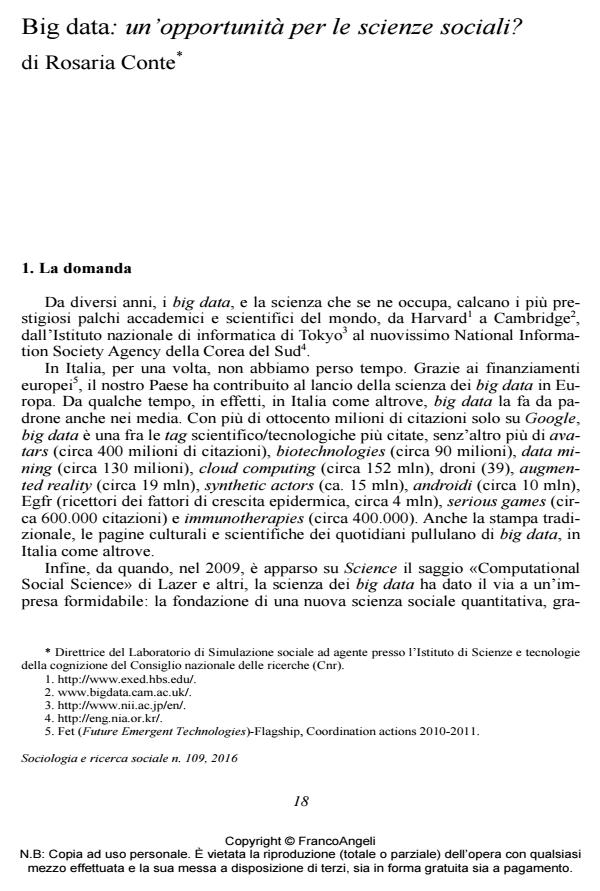Big Data: A Real Opportunity for the Social Sciences?
Journal title SOCIOLOGIA E RICERCA SOCIALE
Author/s Rosaria Conte
Publishing Year 2016 Issue 2016/109
Language Italian Pages 10 P. 18-27 File size 48 KB
DOI 10.3280/SR2016-109003
DOI is like a bar code for intellectual property: to have more infomation
click here
Below, you can see the article first page
If you want to buy this article in PDF format, you can do it, following the instructions to buy download credits

FrancoAngeli is member of Publishers International Linking Association, Inc (PILA), a not-for-profit association which run the CrossRef service enabling links to and from online scholarly content.
In recent years, Big Data and Big Data science are frontstage both in prestigious scientific institutions around the world, and in the media. Italy has contributed to the launch of Big Data science in Europe. With more than eight hundred million quotes on Google, Big Data is one of the most cited technoscientific tags. Furthermore, since 2009, when Lazar and colleagues published the famous «Computational Social Science» on Science, Big Data science gave impulse to a new formidable endeavor: the creation of a new quantitative social science through the extensive application of Big Data science to the study of social phenomena. Now, a few years after the launch of the quantitative science of society, it is time for a first evaluation. Did Big Data maintain its promises? Does it still represent an opportunity for a new science of society? The answer provided in this paper is mildly positive. Big Data represents a good opportunity for the innovation of the social sciences on condition that (a) the application of data science to social data is global, rather than local, and oriented to policy, rather than profit-making; (b) the objective of predicting future events does not inhibit the complementary objective of science, i.e. explanatory speculation; and finally (c) quantitative science does not lead to dispense away with the understanding of the cognitive, social, cultural, and political mechanisms that generate social data
- Types of Big Data and designs of evaluation research Biagio Aragona, in RIV Rassegna Italiana di Valutazione 68/2018 pp.48
DOI: 10.3280/RIV2017-068004 - Data Science and Social Research II Enrica Amaturo, Biagio Aragona, pp.1 (ISBN:978-3-030-51221-7)
- Handbook of Research on Advanced Research Methodologies for a Digital Society Enrica Amaturo, Biagio Aragona, pp.1 (ISBN:9781799884736)
- Per un’epistemologia del digitale: note sull’uso di big data e computazione nella ricerca sociale Enrica Amaturo, Biagio Aragona, in Quaderni di Sociologia /2019 pp.71
DOI: 10.4000/qds.3508 - What People Leave Behind Barbara Sonzogni, pp.293 (ISBN:978-3-031-11755-8)
Rosaria Conte, Big data: un’opportunità per le scienze sociali? in "SOCIOLOGIA E RICERCA SOCIALE " 109/2016, pp 18-27, DOI: 10.3280/SR2016-109003